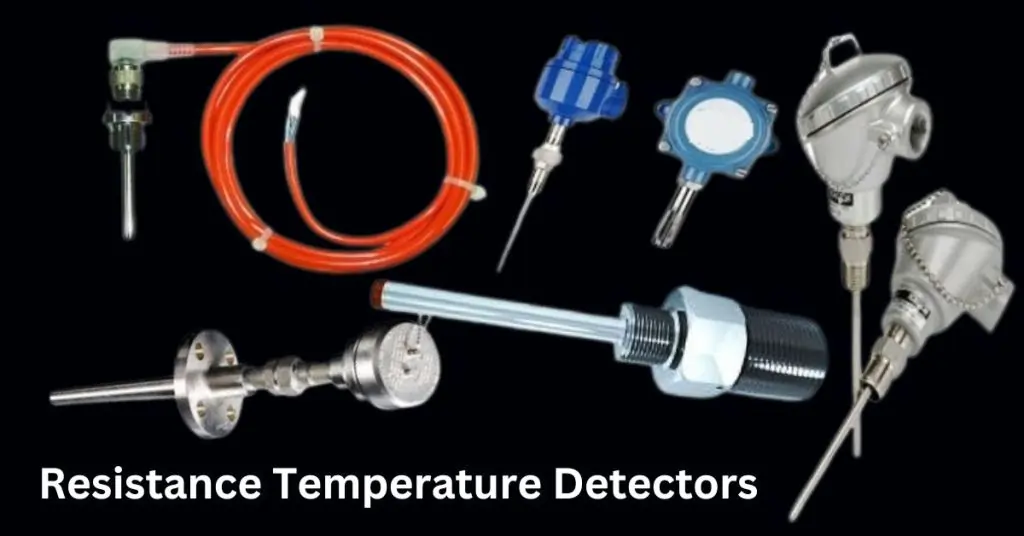Resistance Temperature Detectors
Resistance Temperature Detectors (RTDs) are crucial sensors used in various industries to measure temperature with high accuracy and precision. These sensors operate based on the principle that the electrical resistance of certain materials changes predictably with temperature. Accurate temperature measurement is vital in industries such as manufacturing, power generation, and marine applications, where precise control over temperature can affect safety, efficiency, and product quality.
In this comprehensive 2024 guide, we delve into the fundamental aspects of RTDs, exploring their working principles, types, and key components. We will discuss their applications in both industrial and marine settings, highlighting the benefits of their use in main engines, generators, and auxiliary equipment. Additionally, the guide will compare RTDs with other temperature sensors like thermocouples, provide best practices for calibration and maintenance, and present the latest advancements in RTD technology. This guide aims to equip you with the knowledge to effectively utilize RTDs for optimal temperature measurement.
Understanding RTDs
Basic Principles of How RTDs Work
Resistance Temperature Detectors (RTDs) are temperature sensors that measure temperature by correlating the resistance of the RTD element with temperature. RTDs operate based on the principle that the electrical resistance of certain materials changes predictably with temperature. The most commonly used material for RTD elements is platinum, known for its stable and repeatable resistance-temperature relationship. The resistance-temperature relationship is often linear and can be described by the Callendar-Van Dusen equation, especially for platinum RTDs.
Key Components and Materials Used in RTDs
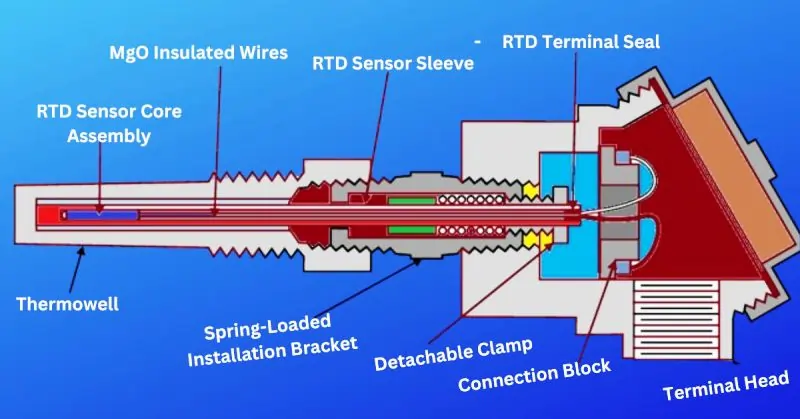
- RTD Terminal Seal:
The RTD Terminal Seal, also known as the RTD Lead Seal, is crucial for protecting the RTD from environmental contamination. It ensures the integrity of the sensor by preventing moisture and other contaminants from entering the connection points. - RTD Sensor Sleeve:
The RTD Sensor Sleeve, or RTD Probe Sheath, is a protective covering that encases the RTD element. It provides mechanical protection and ensures the sensor can withstand harsh operating conditions. Common materials for the sheath include stainless steel and other corrosion-resistant alloys. - MgO Insulated Wires:
MgO Insulated Wires, synonymous with Magnesium Oxide Insulated Wires, provide excellent thermal conductivity and electrical insulation. These wires are used to insulate the RTD element, enhancing its durability and accuracy by protecting it from high temperatures and environmental factors. - RTD Sensor Core Assembly:
The RTD Sensor Core Assembly, or RTD Sensing Element Subassembly, consists of the RTD element and its immediate protective components. This assembly is the heart of the RTD, where the temperature measurement takes place. - Terminal Head:
The Terminal Head, also known as the Connection Head, houses the electrical connections for the RTD. It provides a secure and accessible location for connecting the RTD to external measurement devices, ensuring reliable signal transmission. - Connection Block:
The Connection Block, or Terminal Block, is used within the Terminal Head to facilitate the electrical connections. It provides a structured and organized method for connecting the RTD wires to the external circuitry. - Detachable Clamp:
The Detachable Clamp, synonymous with Removable Retainer, is used to secure the RTD in place within its installation environment. It allows for easy removal and replacement of the RTD without disrupting the surrounding setup. - Spring-Loaded Installation Bracket;
The Spring-Loaded Installation Bracket, also known as Spring Loaded Mounting Fitting, ensures that the RTD maintains good contact with the measured surface or medium. The spring mechanism allows for slight adjustments, accommodating thermal expansion and contraction. - Thermowell:
The Thermowell, or Temperature Sensor Well, is a protective enclosure installed into the process media. It houses the RTD sensor sleeve, allowing for sensor replacement without breaching the process environment. Thermowells are essential for protecting the RTD from high pressure, corrosive media, and mechanical damage.
RTD Accuracy and Precision Overview
| Section | Details |
|---|---|
| Explanation of How RTDs Provide Accurate and Precise Temperature Measurements | RTDs offer high accuracy and precision through a predictable and stable relationship between temperature and electrical resistance. Platinum RTDs, in particular, exhibit a highly linear and repeatable change in resistance with temperature. This linear behavior allows for precise conversion of resistance values to temperature readings using the Callendar-Van Dusen equation. |
| Advantages of RTDs | Linearity: Highly linear resistance-temperature relationship reduces the need for complex calibration. Stability: Long-term stability and repeatability ensure consistent measurements over time. Sensitivity: High sensitivity to small temperature changes allows for precise control and monitoring. Low Drift: Minimal drift over time reduces the frequency of recalibration. |
| Comparison with Other Temperature Sensors (e.g., Thermocouples) | Accuracy: RTDs generally provide higher accuracy within their operational range compared to thermocouples. Stability and Drift: RTDs offer better long-term stability and lower drift. Linearity: RTDs have a more linear response to temperature changes, simplifying resistance-to-temperature conversion. Sensitivity: RTDs are more sensitive to small temperature changes, while thermocouples are suited for rapid changes or extreme temperatures. |
| Applications Where Accuracy is Critical | Industrial Processes: Precise temperature control in manufacturing and process industries ensures product quality and safety. Power Generation: Accurate temperature measurement in power plants optimizes performance and prevents overheating. Marine Applications: RTDs monitor temperatures of main engines, generators, and auxiliary equipment to maintain performance and prevent failures. HVAC Systems: Precise control over heating and cooling systems in HVAC ensures comfort and energy efficiency. Laboratory and Research: Accurate temperature control is essential for experiments and data accuracy in scientific research and laboratory settings. |
Industrial and Marine Applications of RTDs
Detailed Exploration of Various Industrial Applications of RTDs
RTDs are essential in various industrial applications due to their high accuracy, stability, and reliability. They are commonly used in the following sectors:
Manufacturing
- Process Control: RTDs are used to monitor and control temperatures in manufacturing processes, ensuring product quality and consistency. For example, in the chemical industry, precise temperature control is critical for safe and efficient reactions.
- Quality Assurance: Consistent and accurate temperature measurements help maintain high standards in product quality. In the food and beverage industry, RTDs ensure that products are processed at safe temperatures, preventing spoilage and contamination.
- Automation Systems: In automated manufacturing environments, RTDs provide real-time temperature data that is crucial for the operation of automated systems, reducing downtime and improving efficiency.
Power Generation
- Turbine Monitoring: RTDs are used to monitor the temperature of turbines in power plants. Accurate temperature readings help optimize turbine performance and prevent overheating, leading to increased efficiency and longevity.
- Boiler Control: In steam generation, RTDs measure the temperature of boiler water and steam, ensuring that the system operates within safe and efficient parameters.
- Environmental Compliance: RTDs are used to monitor emissions and other environmental factors in power plants, ensuring compliance with regulations and reducing the environmental impact of power generation activities.
HVAC Systems
- Temperature Control: RTDs are integral to the operation of heating, ventilation, and air conditioning (HVAC) systems. They provide precise temperature measurements that help maintain comfortable and energy-efficient indoor environments.
- Energy Management: Accurate temperature monitoring with RTDs enables better energy management, reducing operational costs and improving the efficiency of HVAC systems.
- Maintenance and Diagnostics: RTDs help in the early detection of potential issues in HVAC systems, allowing for preventive maintenance and reducing the risk of system failures.
Use of RTDs in Marine Applications
RTDs are widely used in marine environments due to their robustness and reliability under harsh conditions. Key applications include:
Main Engines
- Engine Temperature Monitoring: RTDs are used to monitor the temperature of main engines on ships. Precise temperature readings are essential for maintaining engine performance and preventing overheating.
- Lubrication Systems: RTDs measure the temperature of engine lubricants, ensuring that they operate within optimal temperature ranges for effective lubrication and reduced wear.
Generators
- Generator Temperature Control: RTDs provide accurate temperature measurements for generators, helping to optimize their performance and prevent overheating.
- Cooling Systems: RTDs monitor the temperature of cooling systems for generators, ensuring that they function efficiently and prevent thermal damage to the equipment.
Auxiliary Equipment
- Temperature Monitoring: RTDs are used to monitor the temperature of various auxiliary systems on ships, such as pumps, compressors, and heating systems. This helps ensure the reliable operation of these critical components.
- Preventive Maintenance: By providing accurate and consistent temperature readings, RTDs help in the early detection of potential issues, allowing for timely maintenance and reducing the risk of equipment failure.
Types of RTDs: Overview, Use Cases, and Advantages
| Type of RTD | Overview | Specific Use Cases | Advantages |
|---|---|---|---|
| Platinum RTDs | Platinum RTDs are the most common type, known for their high accuracy and stability. They have a linear resistance-temperature relationship and are highly reliable over a wide temperature range. | Industrial process control Laboratory and research applications Power generation HVAC systems | High accuracy and precision Excellent long-term stability Wide temperature range (-200°C to 850°C) Good repeatability |
| Nickel RTDs | Nickel RTDs have a higher temperature coefficient of resistance than platinum RTDs, providing a more sensitive response to temperature changes. However, they are less stable and have a limited temperature range. | HVAC systems Automotive applications Consumer electronics | High sensitivity Cost-effective for certain applications Suitable for moderate temperature ranges (-60°C to 180°C) |
| Copper RTDs | Copper RTDs are known for their excellent conductivity and linearity, but they are typically used in applications where the temperature range is limited. Copper RTDs are less expensive than platinum RTDs. | Electrical motor windings Transformer temperature monitoring HVAC systems | Excellent electrical conductivity Good linearity Cost-effective Suitable for narrow temperature ranges (-200°C to 260°C) |
Comparison with Thermocouples
| Aspect | RTDs | Thermocouples |
|---|---|---|
| Performance | High accuracy and precision Stable and linear resistance-temperature relationship Suitable for a wide temperature range (-200°C to 850°C for platinum RTDs) | Wider temperature range (-200°C to 1700°C) Faster response time Non-linear temperature-voltage relationship, requiring compensation |
| Cost | Generally more expensive, especially platinum RTDs Higher initial cost but long-term cost-effective due to stability and low drift | Typically lower initial cost Lower cost materials (e.g., Type K thermocouples) Potentially higher long-term costs due to drift and degradation |
| Suitability for Different Applications | Ideal for applications requiring high accuracy and stability (e.g., industrial process control, laboratory research, HVAC systems, power generation) Better for steady-state temperature measurements | Suitable for applications needing wide temperature range and quick response (e.g., kilns, gas turbine exhaust, high-temperature furnaces) Better for dynamic temperature changes and high-temperature environments |
| Pros and Cons of Using RTDs vs. Thermocouples | Pros: High accuracy and stability Better repeatability Less susceptible to drift Cons: Higher initial cost Slower response time compared to thermocouples | Pros: Lower initial cost Wider temperature range Faster response time Cons: Less accurate and stable over time Non-linear output requires compensation More susceptible to drift and degradation |
Calibration and Maintenance for RTDs
| Aspect | Details |
|---|---|
| Best Practices for Calibrating RTDs | Use Standard Reference Materials: Calibrate against standard reference materials with known and certified temperature values. Calibration Equipment: Utilize high-precision equipment like temperature baths, dry-block calibrators, or fixed-point cells. Three-Point Calibration: Perform at least three-point calibration covering the lower, middle, and upper operating range. Document Calibration Data: Keep detailed records of calibration data for traceability. Regular Calibration Intervals: Adhere to regular calibration intervals based on application criticality and manufacturer recommendations. |
| Regular Maintenance Routines | Visual Inspections: Inspect RTDs for physical damage, corrosion, or wear regularly. Clean Connections: Ensure all electrical connections are clean and secure. Check Insulation Resistance: Periodically check insulation resistance using a megohmmeter. Verify Output Signals: Compare RTD output signals against known reference temperatures periodically. Environmental Protection: Protect RTDs from harsh conditions using enclosures or thermowells. |
| Common Issues and Troubleshooting Tips | Drift in Readings: Cause: Aging, mechanical stress, or contamination. Solution: Recalibrate or replace the sensor. Erratic Readings: Cause: Loose or corroded connections, electrical noise, or damaged lead wires. Solution: Tighten and clean connections, check for noise, inspect lead wires. Nonlinear Output: Cause: Incorrect wiring, poor calibration, or damaged element. Solution: Verify wiring, recalibrate, check for damage. Open or Short Circuits: Cause: Broken lead wires, internal sensor failure, or connector issues. Solution: Inspect and replace damaged wires, check connectors, replace RTD. Temperature Reading Offsets: Cause: Calibration drift, thermal shunting, or environmental interference. Solution: Recalibrate, ensure proper installation, mitigate interference. |
Temperature Range and Sensitivity of RTDs
| Aspect | Details |
|---|---|
| Explanation of Temperature Range and Sensitivity | Temperature Range: RTDs, particularly those made from platinum, typically operate within a range of -200°C to 850°C. Nickel RTDs cover a range of -60°C to 180°C, and copper RTDs operate from -200°C to 260°C. Sensitivity: RTDs exhibit high sensitivity due to their predictable change in resistance with temperature. The temperature coefficient of resistance (TCR) indicates the change in resistance per degree Celsius. Platinum RTDs have a TCR of approximately 0.00385 Ω/Ω/°C. |
| Impact on Measurement Performance | Accuracy: High sensitivity and a wide temperature range contribute to the precise measurement capabilities of RTDs, making them suitable for applications requiring accurate temperature control. Stability: RTDs provide stable and repeatable measurements over long periods, reducing the need for frequent recalibration. Linearity: The linear relationship between resistance and temperature simplifies the conversion process, enhancing measurement reliability. Response Time: RTDs generally have a slower response time compared to thermocouples, which can impact applications requiring rapid temperature changes. |
| Examples of Applications Requiring Specific Temperature Ranges and Sensitivities | Industrial Processes: Accurate temperature control in processes such as chemical reactions, metal treatment, and food processing requires RTDs with a wide temperature range and high sensitivity. Power Generation: Monitoring and controlling temperatures in turbines and boilers demand RTDs that can operate accurately over a broad temperature range. HVAC Systems: Maintaining precise indoor climate control relies on RTDs for their sensitivity and accuracy within the operational temperature range of HVAC systems. Marine Applications: RTDs monitor critical temperatures in main engines, generators, and auxiliary equipment, ensuring optimal performance and preventing overheating. Laboratory and Research: Experiments and calibrations in scientific research require RTDs with high sensitivity and stability to ensure accurate temperature measurements. Aerospace: RTDs in aerospace applications must operate over extreme temperature ranges and provide precise readings for safety and performance. |
Important Design Formulas and Calculations for RTDs
Key Formulas Used in the Design and Implementation of RTDs
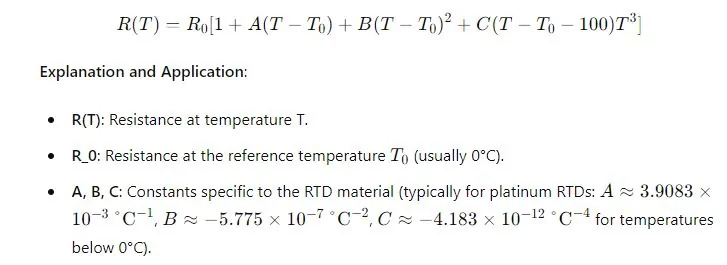
This equation is used to calculate the resistance of a platinum RTD at a given temperature. It accounts for the non-linearity in the resistance-temperature relationship, especially at lower temperatures.
Example Calculation:

Temperature Coefficient of Resistance (α)
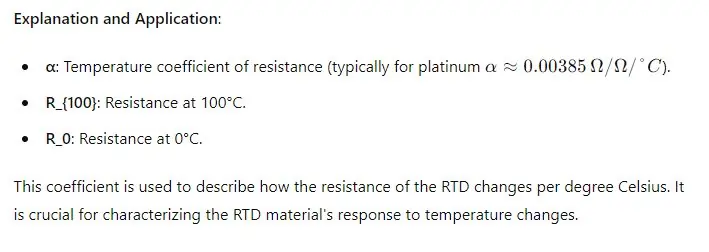
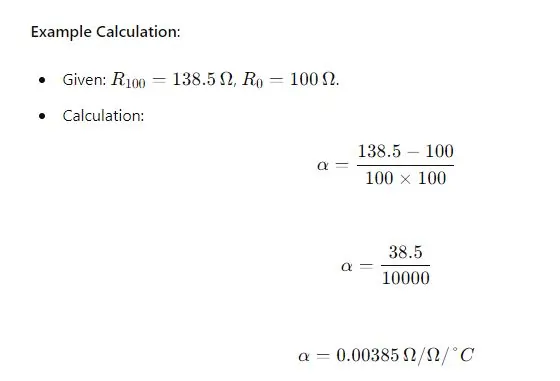
Advancements in RTD Technology
| Aspect | Details |
|---|---|
| Latest Advancements and Innovations | Thin-Film RTDs: Development of thin-film RTDs has improved sensitivity and reduced size, making them suitable for compact and precise applications. Nanotechnology: Incorporation of nanomaterials enhances the performance and durability of RTDs, allowing for higher temperature ranges and better accuracy. Wireless RTDs: Innovations in wireless technology enable real-time temperature monitoring without the need for wired connections, improving flexibility and ease of installation. Self-Calibrating RTDs: Advances in self-calibrating technology ensure continuous accuracy and reduce the need for manual recalibration, enhancing long-term reliability. |
| Implications for Future Applications | Increased Precision: Improved materials and manufacturing techniques will lead to RTDs with even higher precision, suitable for critical applications in aerospace, medical, and scientific research. Expanded Temperature Ranges: Enhanced RTD designs can withstand more extreme temperatures, making them applicable in industries like metallurgy and advanced manufacturing. Greater Durability: Advances in protective coatings and materials will increase the lifespan of RTDs, reducing maintenance costs and downtime. Integration with IoT: Wireless and smart RTDs will integrate seamlessly with Internet of Things (IoT) systems, allowing for more sophisticated data collection and analysis in real-time. |
| Predictions for the Future of RTD Technology | Smart RTD Sensors: The development of RTDs with built-in intelligence will enable predictive maintenance and real-time adjustments, improving process efficiency. Eco-Friendly Materials: Future RTDs will utilize more sustainable and eco-friendly materials, aligning with global environmental goals. Advanced Manufacturing: Techniques such as additive manufacturing (3D printing) will produce more complex and customized RTD designs, tailored for specific applications. Global Standardization: Increased collaboration among international standards organizations will lead to uniform RTD specifications, facilitating global trade and application. |
FAQ on RTDs
Q: What does RTD stand for?
A: RTD stands for Resistance Temperature Detector.
Q: What materials are commonly used in RTDs?
A: Platinum, nickel, and copper are commonly used materials in RTDs.
Q: How do RTDs measure temperature?
A: RTDs measure temperature by correlating the resistance change of their material with temperature changes.
Q: What are the advantages of using RTDs over thermocouples?
A: RTDs offer higher accuracy, stability, and repeatability compared to thermocouples.
Conclusion
RTDs (Resistance Temperature Detectors) are vital for accurate and reliable temperature measurement across various industries, from manufacturing and power generation to marine and HVAC systems. Their high precision, stability, and long-term reliability make them the preferred choice for critical applications. Advances in RTD technology, including thin-film sensors, nanotechnology, and wireless capabilities, continue to enhance their performance and expand their applications. By understanding the principles, types, and maintenance of RTDs, as well as staying informed about the latest innovations, professionals can ensure optimal temperature control and efficiency in their operations. Embracing these advancements will pave the way for more sophisticated and effective temperature measurement solutions in the future.
